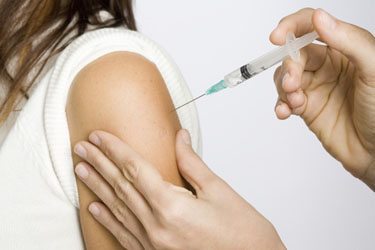New Research on HPV: Some Good News, Some Bad News
The bad news is that neck and throat cancers are rising, and this common sexually transmitted infection seems to be the cause. The good news: The vaccines that are available to prevent infection seem to protect against these kinds of cancers as well.

Last month, actor Michael Douglas made headlines (and made TV anchors giggle) when he suggested that the throat cancer he battled a few years ago was caused not by cigarettes but by cunnilingus. His announcement helped bring to light the rising number of throat and neck cancers that have shown to be caused by the human papillomavirus (HPV)—a sexually transmitted infection that also causes genital warts and cervical cancer. The publicity also gave public health experts a chance to discuss vaccines that are available to prevent infection with those strains of HPV that are most likely to cause cervical cancer. Now, two new studies show just how timely and important Douglas’ announcement really was. The first finds that up to one-third of throat cancers are caused by HPV, while the other suggests that the vaccines can protect against those kind of cancers as well.
Released in the Journal of Clinical Oncology, the first study looked at plasma samples from participants in the European Prospective Investigation Into Cancer and Nutrition study who had been followed for many years. Specifically, the researchers compared 638 participants who had oropharyngeal cancer (cancer of the mouth, oropharynx, or larynx), 300 who had cancer of the esophagus, and 1,599 who did not have cancer. The tested samples were taken from participants before they had been diagnosed with cancer (on average, six years before diagnosis).
The researchers found that HPV 16, one of the strains also responsible for cervical cancer, was found in 34.8 percent of patients with oropharyngeal cancer and only 0.6 percent of patients in the control group. HPV was not correlated with cancers in other locations. Some participants had evidence of HPV 16 in their throats in samples taken as many as ten years before their cancer diagnosis. Dr. Ruth Travis, an Oxford cancer researcher and one of the study’s authors, said in a statement, “These striking results provide some evidence that HPV 16 infection may be a significant cause of oropharyngeal cancer.”
In fact, the findings suggest that about 7 percent of non-smoking women and 23 percent of non-smoking men who contract HPV of the throat will develop cancer over ten years. It is thought that men who perform oral sex on women have a higher risk of contracting HPV than either women or men who have sex with men because vaginal fluids have a higher concentration of the virus than the surface of the penis. Smokers and those who drink excessive amounts of alcohol also are at increased risk.
The second study, which was supported by the National Cancer Institutes and published in the journal PLOS One, looked at whether one of two HPV vaccines on the market could provide protection against cancers of the neck and throat. Researchers tested cells from the throats of 5,840 women in Costa Rica for presence of HPV strains 16 or 18. The women were part of a larger study on the vaccines that had begun four years earlier. Some were vaccinated with Cervarix, while others received a placebo. (The other vaccine on the market, Gardasil, was not used in this study, but researchers believe the results will apply to both.) Of the women who had been vaccinated, only one was infected, compared to 15 of the woman who had received placebo shots.
Researchers were very pleased with these results. Dr. Rolando Herrero, the study’s lead author as well as head of prevention for the World Health Organization’s International Agency for Research on Cancer, told the New York Times, “We were surprised at how big the effect was. It’s a very powerful vaccine.”
Herrero cautions, however, that the study does have a number of limitations. First, when it began it was designed only to test the vaccine’s efficacy in preventing cervical cancer. While all women were tested to be sure they did not already have a cervical infection at the start of the study, they were not tested to see if they had HPV in their throats. This means that some of the infections found either in the placebo or the vaccine group could have been present before the study started.
Another challenge in testing the vaccine’s ability to prevent cancer is how slow cancers of the neck and throat tend to grow. Cancers caused by HPV would not have grown during the four-year study, and, if the women were studied longer, it would not be ethical to ask those who had lesions that looked like they might become cancer to forgo treatment for the sake of the study. Moreover, it’s likely that the women who tested positive for HPV would never develop cancer even without intervention, because in many cases the body can clear itself of the virus before it becomes a problem.
Despite such limitations, researchers believe the study shows the potential of the vaccine. As Dr. Marshall Posner, medical director for head and neck cancer at Mount Sinai Medical Center in New York, told the New York Times, “We expected this—that’s why we want everyone to vaccinate both boys and girls. But there’s been no proof.”
Together, these studies seem to create a bad news-good news situation. The bad news is that head and neck cancers are on the rise, and HPV appears to be the culprit. The good news is that we have a way to prevent HPV infection. As with most developments in science around HPV, these studies provide more good reasons to get both girls and boys vaccinated before they become sexually active.
